15 Types of Thrush Birds: An Overview (with Pictures)
Last Updated on
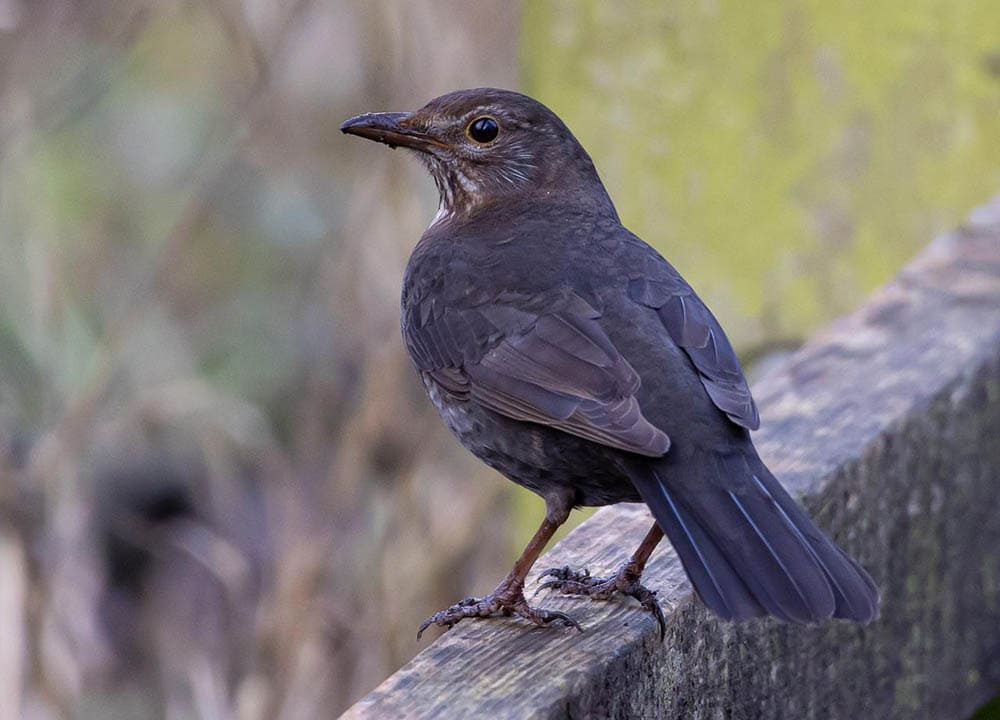
Thrushes are unique birds that come in various colors and sizes, and you can find them throughout the world. They are songbirds, and each thrush species has a distinctive song that makes them stand out from other thrush species.
To make you more familiar with the thrush breed, we listed 15 types of thrush birds below, so check out each species and its characteristics.

The 15 Types of Thrush Birds
1. Dusky Thrush
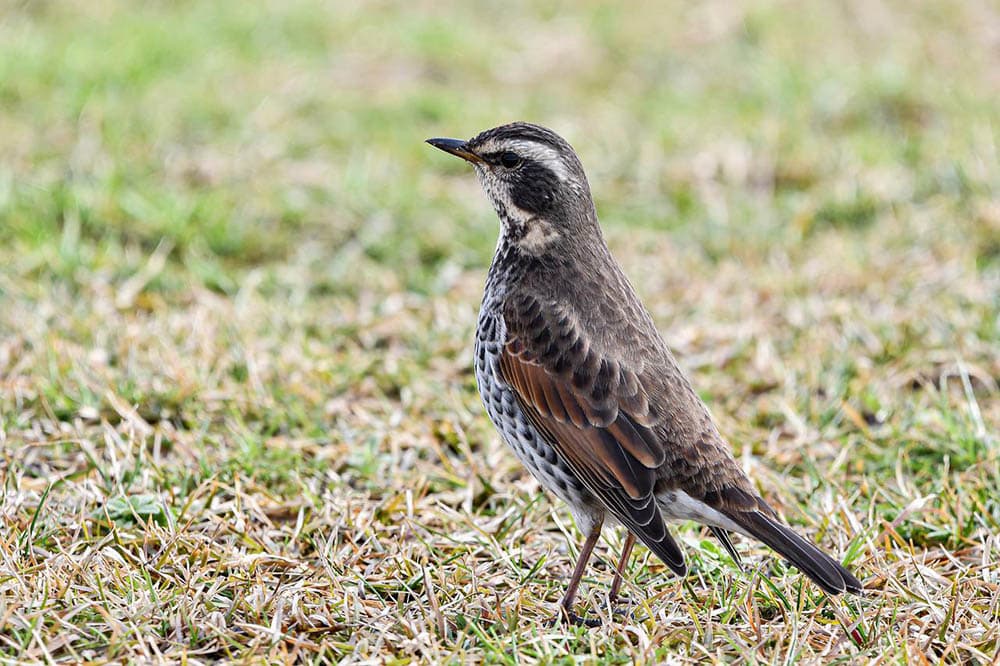
| Scientific name: | Turdus eunomus |
| Length: | 9 inches |
| Wingspan: | 14 inches |
| Weight: | 3 ounces |
The Dusky Thrush is a medium to a large thrush bird. These birds tend to be very shy and have a fascinating brown-colored pattern on their plumage. Their wings are rounded and have a specific reddish-brown color, while the entire head is black with white stripes covering the face and neck.
The rest of their body has black and white spots that give the Dusky Thrush an alluring appearance. The male’s song is composed of short whistles and is gloomy and melodic. This bird is a ground-feeder and it mostly hunts earthworms, insects, larvae, spiders, ants, fruits, and seeds.
2. Mistle Thrush

| Scientific name: | Turdus viscivorus |
| Length: | 10 inches |
| Wingspan: | 16–19 inches |
| Weight: | 3–5 ounces |
The Mistle Thrush is a large songbird you can find in parks, yards, woodlands, and scrub habitats. Its common name comes from its fondness for mistletoe. It’s a pale gray-brown bird with creamy undersides and dark rounded markings. These birds stand tall and leap across fields while being powerful and aggressive. It’s most likely to be seen perched high in a tree, chirping its fluty melody or making a rattling sound as it flies.
3. Fieldfare

| Scientific name: | Turdus pilaris |
| Length: | 9–10 inches |
| Wingspan: | 15–16 inches |
| Weight: | 3–5 ounces |
Fieldfares are big, colorful thrushes that are similar in size, shape, and behavior to mistle thrushes. They look very appealing with a blue-gray head, rich chestnut-brown back, gray tail, and a peachy-buff wash over the breast. These birds are friendly, and they spend the winter in flocks of up to several hundred birds. The behavior of their flocks is pleasant, and it’s an exciting sight to witness in the countryside. The song of the Fieldfare is not that appealing since it consists of a sequence of scratchy and jumbled sounds.
4. Redwing
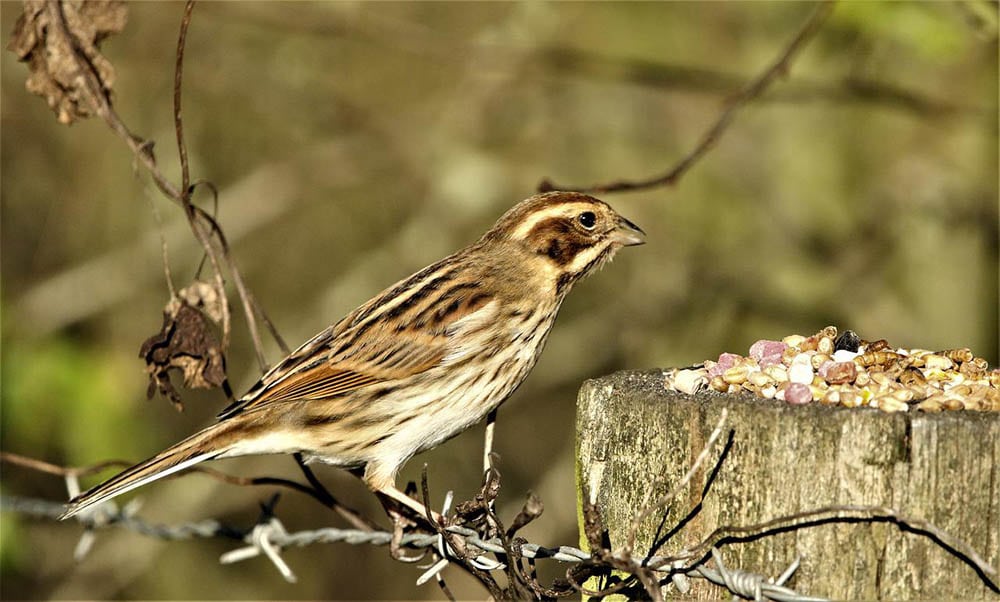
| Scientific name: | Turdus iliacus |
| Length: | 8 inches |
| Wingspan: | 13 inches |
| Weight: | 2 ounces |
The Redwing is a smaller, berry-loving thrush, very similar to the American Robin. You can encounter them in woodlands, grasslands, and farmlands, mainly during winter. These birds have dark wings, a white-spotted belly, and an orange underwing. Their bills are yellow with a black top, while their heads have white stripes. When flying, the Redwing rapidly beats its wings and remains gracious and strong during the flight.
They are commonly found in flocks with anywhere from 20 to 100 birds, and they typically mix with other birds such as blackbirds and starlings. When singing, the Redwing shows its exceptional abilities to bring out a lovely song with whistles, trills, and buzzing.
5. Song Thrush

| Scientific name: | Turdus philomelos |
| Length: | 9 inches |
| Wingspan: | 13–14 inches |
| Weight: | 2–3 ounces |
The Song Thrush is a smaller bird that typically breeds through the West Palearctic. It has brown plumage and a white belly with brown, drop-shaped spots, similar to the Redwing and Mistle Thrush. Their habitats are commonly woodlands such as parks, gardens, and farmlands with tall trees and hedges. They breed throughout spring, mainly from March to April, and they produce beautiful blue eggs with spots. These birds live up to their name since they have stunning, loud songs with repeated sounds and phrases.
6. Ring Ouzel

| Scientific name: | Turdus torquatus |
| Length: | 9 inches |
| Wingspan: | 15 inches |
| Weight: | 3–4 ounces |
The Ring Ouzel is a medium-sized thrush that resembles a blackbird, although it’s smaller and slimmer. They are easily recognizable due to their black plumage with paler wings and white stripe on the belly. Their bills are yellow and have a black tip. These birds are primarily European, and you won’t encounter them in the USA.
Males of the species are singers, and their song is beautiful, but it creates a feeling of loneliness in the listener. You can find them in open highlands, rocky mountainsides, and alpine meadows. These thrushes feed on worms, berries, and insects.
7. American Robin
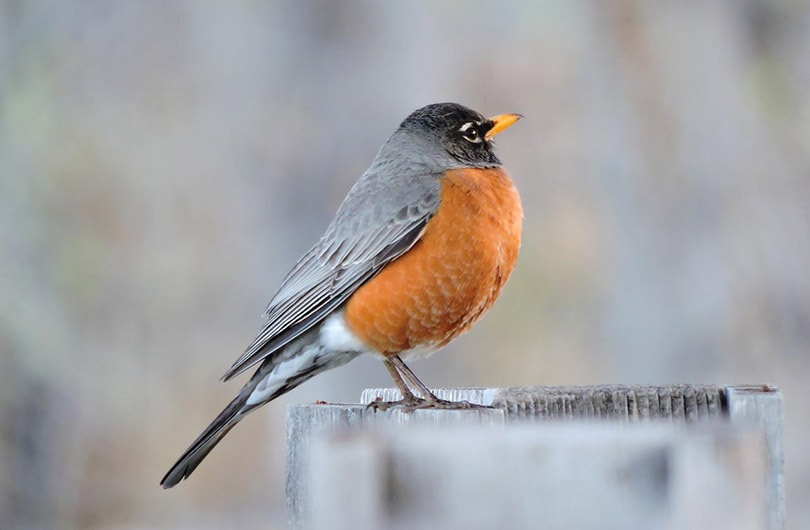
| Scientific name: | Turdus migratorius |
| Length: | 8–10 inches |
| Wingspan: | 12–16 inches |
| Weight: | 2–3 ounces |
The American Robin is a reasonably large bird widely spread throughout North America, and you can even draw them to your backyard. They have gray wings and a black head, while their belly and bill are orange. You’ll commonly see them in large flocks during winter and fall, where they eat berries or gather in trees to roost.
They reside in parks, woodlands, shrublands, and yards. These songbirds commonly eat earthworms, fruits, and berries. Their song has rich notes that rise and fall in pitch.
8. Bicknell’s Thrush
https://www.instagram.com/p/CdhUuB0NrdJ/
| Scientific name: | Catharus bicknelli |
| Length: | 6–7 inches |
| Wingspan: | 11–12 inches |
| Weight: | 1 ounce |
The Bicknell’s Thrush is a smaller species with gray wings and heads and a white belly with brown dots. These birds are pretty similar to the gray-cheeked thrush when it comes to their appearance. They are typically terrestrial, so they will hop on the ground to search for fruit and invertebrates and look for insects. The Bicknell’s Thrush commonly lives in forests with dense vegetation. Their song has a wiry tone, with rising vocals during the final note.
9. Clay-colored Thrush
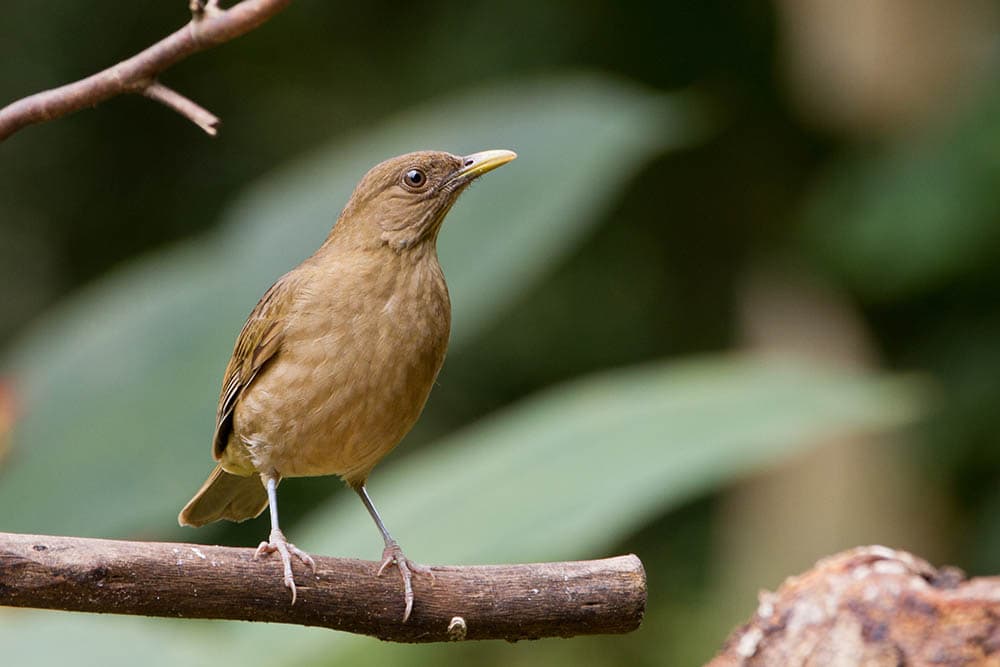
| Scientific name: | Turdus grayi |
| Length: | 9–10 inches |
| Wingspan: | 14 inches |
| Weight: | 2 ounces |
The Clay-colored Thrush got its name due to the unique clay color that spreads throughout their bodies. Their wings are commonly olive-brownish, while their bellies are lighter in color. It’s the national bird of Costa Rica, and it’s widespread in Central America, although you’ll seldomly encounter it in the US. These birds live in shrubby woodlands, towns, and parks. Their song is slow and consists of whistled notes and high pitches that follow the same tempo.
10. Eyebrowed Thrush
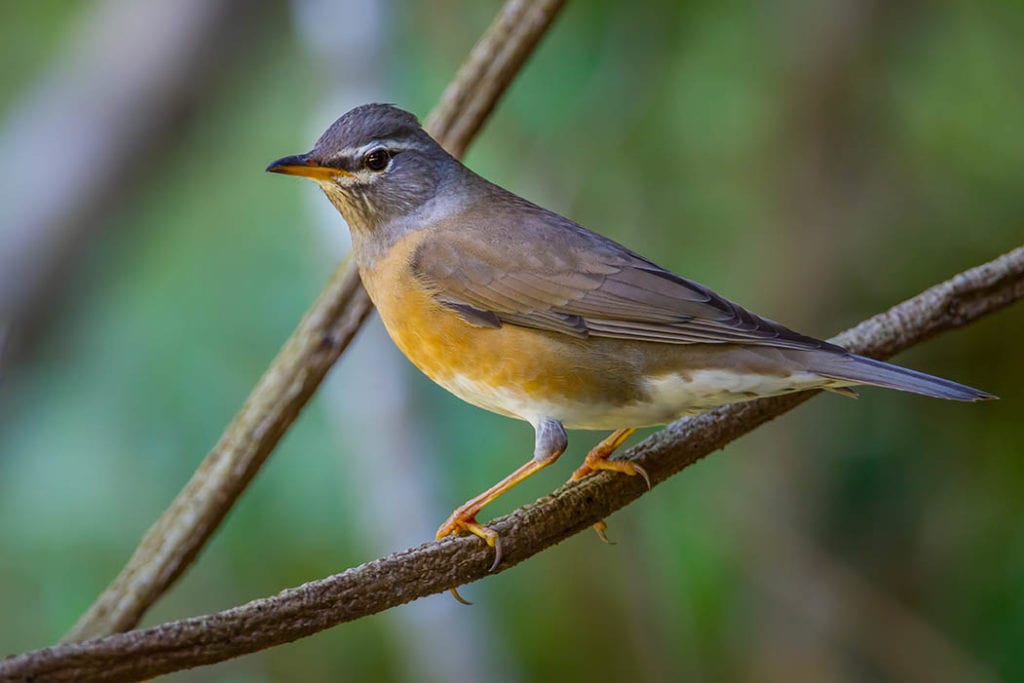
| Scientific name: | Turdus obscurus |
| Length: | 9 inches |
| Wingspan: | 14 inches |
| Weight: | 2 ounces |
The Eyebrowed Thrush got its name due to the white “eyebrows” that give these birds their distinctive look. Their wings are brownish with darker ends, and their bellies are orange-gray, while their bills are commonly orange with a black tip. They will occasionally visit Alaska, mainly in springtime.
These birds live in dense Siberian forests where there’s plenty of water. Their song has buzzy whistles and rich warbling, making them easily recognizable compared to other thrushes.
11. Hermit Thrush
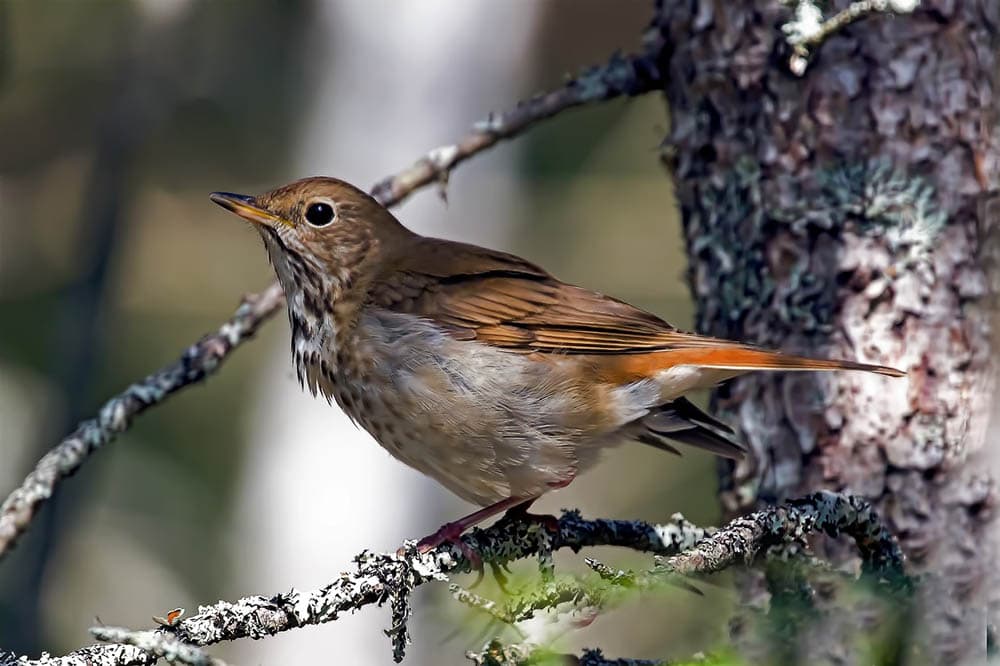
| Scientific name: | Catharus guttatus |
| Length: | 5–7 inches |
| Wingspan: | 9–11 inches |
| Weight: | 1–3 ounces |
The Hermit Thrush is a medium-sized, light-brownish thrush with dark spots on its belly and a reddish tail. Their bills are slightly orange with dark, black tips. They are commonly terrestrial and will forage on the forest floor to find insects and seeds. Widespread throughout North America, you can notice these birds in forest understories, typically around openings or edges. Their song has a dose of melancholy, with flute-like tones and multiple phases in different pitches.
12. Varied Thrush

| Scientific name: | Ixoreus naevius |
| Length: | 7–10 inches |
| Wingspan: | 13–15 inches |
| Weight: | 2–4 ounces |
The Varied Thrush is easily recognizable due to the stunning shades of orange on its body. Their wings are black with orange stripes and sections, while their bellies are rich-orange. These birds have a black head with orange “eyebrows,” and their bills are black. They mainly eat insects, fruits, and nuts that they find on the ground or in low trees and shrubs.
The Varied Thrush is commonly seen in evergreen forests while visiting parks, backyards, and gardens during winter. Their song consists of slow, long whistles.
13. Red-legged Thrush

| Scientific name: | Turdus plumbeus |
| Length: | 10 inches |
| Wingspan: | 16 inches |
| Weight: | 2–3 ounces |
The Red-legged Thrush, as the name implies, has red legs that make this species stand out. Their eyes are also red, while their bills have reddish hues. These birds have blue-gray bodies, with dark marks on the wings, tail, and neck, as well as around their eyes.
They can be found in multiple habitats such as woodlands, gardens, and tropical forests. When they sing, you can hear whistled couplets that include chucks, squeaks, and consistent melodies.
14. White-throated Thrush

| Scientific name: | Turdus assimilis |
| Length: | 9 inches |
| Wingspan: | 14–16 inches |
| Weight: | 2 ounces |
The White-throated Thrush is a species known for its white throat and belly. The former name of this species was White-throated Robin. Their backs, heads, and wings are rich-brown, while their throats have deep-brown stripes. You can encounter them in forests, highlands, and foothills, especially if the area is moist and has a lot of water resources.
Like other thrushes, the White-throated Thrush feeds on insects, berries, and fruits. Their song has satisfying warbling with repeated phrases.
15. Wood Thrush

| Scientific name: | Hylocichla mustelina |
| Length: | 7–8 inches |
| Wingspan: | 11–13 inches |
| Weight: | 1–2 ounces |
The Wood Thrush commonly lives in the eastern US. These birds have reddish-brown wings and a white belly with numerous dark spots. They are mostly terrestrial, so they hop on the ground in search of insects, berries, and fruits. You can spot them in forests with large trees and a lot of shade.
During winter, they migrate to tropical forests, mostly in Central America. Their song is complex and consists of low and high notes, finishing with a challenging trill.

Final Thoughts
As you can see, there are many interesting thrush species, and each is unique in its own way. The species we mentioned are just a slight dive into the thrush family, and there are a lot more thrushes throughout the world. If you’re a bird lover, don’t be afraid to explore the species and learn more about their behavior and habits.
Featured Image Credit: TheOtherKev, Pixabay
Table of Contents
About the Author Visnja Radosavljevic
Visnja is a creative, adaptable content writer that covers various topics such as DIY, pets, home improvement, travel, gardening, and more. As a young mom and a college student, she didn’t have enough time to balance her personal and work life, so after multiple years of working a regular 9 to 5 job, she decided to pursue her passion and make a living out of it. She has been writing for a couple of years now, helping people to find valuable and interesting information online.
Related Articles:
Monocular vs Telescope: Differences Explained (With Pictures)
10 Types of Hummingbirds in Arkansas (With Pictures)
8 Types of Hummingbirds in Nebraska (With Pictures)
5 Types of Hummingbirds in Idaho (With Pictures)
3 Types of Hummingbirds in Mississippi (With Pictures)
8 Types of Hummingbirds in Kansas (With Pictures)
5 Types of Hummingbirds in West Virginia (With Pictures)
5 Types of Hummingbirds in Ohio (With Pictures)
